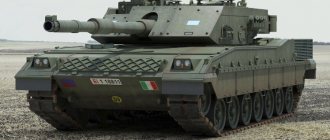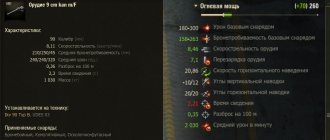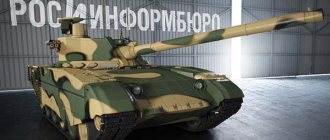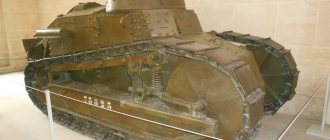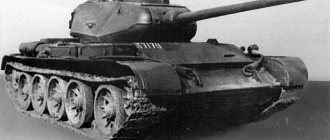Main tanks EE-T1 and EE-T2 Osório (Brazil)
At the end of the seventies, the Brazilian command wanted to update its fleet of armored vehicles.
Initially, it was proposed to modernize the American-made M41 Walker Bulldog light tanks in service, which resulted in the emergence of several projects of the MB-3 Tamoyo family. In addition, the army has expressed the need to obtain completely new equipment of promising models. In order to rearm its own army, as well as with an eye to future export contracts, the EE-T1 and EE-T2 Osório main tanks were developed in Brazil. The equipment fleet renewal program started in the late seventies and initially meant only the modernization of existing vehicles. A few years later, the Brazilian military department formed a technical specification for a new model of armored vehicles, with the help of which the army could significantly increase its defense potential in the foreseeable future. Thus, over the next few years, armored units could receive both modernized M41 tanks and completely new domestically produced equipment.
Main tank EE-T1 Osório. Photo Military-today.com
In accordance with the plans of the Ministry of Defense, three hundred new tanks should have been built. This equipment, in its main characteristics, was supposed to correspond to existing foreign main tanks. In addition, there were special requirements for the mobility of armored vehicles: in order to operate without any problems, the tanks had to comply with the existing transport infrastructure. In particular, it was because of this that the maximum combat weight was limited to 43 tons. The dimensions of the machines, accordingly, were determined taking into account the capabilities of railway transport.
Engesa was one of the first to respond to the military’s call and decided to develop and present its own version of a promising main tank. An interesting fact is that a commercial company had to create a new combat vehicle at its own expense. The development of the tank cost a total of more than $100 million, of which only a minimal portion was contributed by the state. Other expenses were borne by the development company. However, despite certain difficulties, I was able to successfully develop two versions of the project at once, differing in technical features and purpose.
The project to develop a new armored vehicle received its own name Osório in honor of General Manuel Luis Osório, a hero of the Uruguay War. The first version of the project, intended for the rearmament of the Brazilian army, was called EE-T1. The second version of the tank, which was planned to be offered to potential foreign buyers, was designated EE-T2. The unit modification, intended for the Brazilian armed forces, was the basic development of the entire project. It was by processing it that it was planned to create an export tank in the future.
General view of an armored vehicle for the Brazilian army. Figure Tanks-encyclopedia.com
The designers of the Engesa company carefully studied foreign experience in creating modern armored vehicles, thanks to which they were able to create a very interesting appearance for the new tank. Despite the lack of their own tank building school, Brazilian engineers still managed to solve the main problems. However, serious production limitations led to the fact that a significant number of units of the promising tank either had to be purchased abroad or produced in Brazil under license.
Both Engesa Osório projects had to use the same chassis with a certain set of equipment and required armor. In accordance with the type of turret and its armament, it was necessary to make some changes to the chassis design, but even so, the two tanks had the highest possible degree of unification, which could facilitate the production and operation of the equipment.
In accordance with the main trends of its time, the EE-T1 tank received a hull with differentiated armor. The frontal projection was protected by inclined parts of the combined armor, which, according to available data, contained steel, aluminum, ceramic and carbon elements. According to various estimates, the frontal armor of the Osoriu tanks could withstand hits from any shells that existed in the early eighties. To further increase the level of protection of the vehicle, the upper frontal part was located almost horizontally. With its front edge it was in contact with the inclined bottom sheet.
Otherwise, the hull of the Brazilian tank was similar to the corresponding units of foreign analogues. There were vertical sides made of homogeneous armor, to which low fenders were attached. An additional means of protecting the side projection were hinged screens. The layout of the hull was classic. The driver's workplace and some additional devices, such as a rack for ammunition, were placed in the front compartment. The central volume was allocated for the fighting compartment, the stern – for the power unit.
"Ozoriu" overcomes the obstacle. Photo Military-today.com
Not having my own products with the required characteristics, I decided to order power plant units abroad. It was proposed to place a single power unit, including an engine and transmission, in the aft compartment of the hull. This architecture of the engine compartment made it possible to change a failed unit in about 30 minutes. It was proposed to equip the Osório tank with a MWM TBD 234 diesel engine with a power of 1040 hp. The engine was connected to a ZF LSG300 automatic transmission manufactured in Germany. Similar units were used on some other new tanks.
The subcontractor responsible for the development of the suspension was Dunlop. She was ordered hydropneumatic units similar to those used on the British main tanks of the Challenger family. On each side of the EE-T1 there were six road wheels with individual suspension. The guide wheels were placed in the front of the hull, the drive wheels in the stern. The use of several supporting rollers was envisaged. To simplify the project, it was decided to use ready-made tracks. The design of the tracks with the possibility of installing rubber boots was borrowed from the German Leopard 2 tank.
The Osório armored vehicle received a turret built on the same principles as the hull. The turret had a wedge-shaped frontal section with a “recessed” placement of a wide gun mantlet. Vertical sides were provided, behind which there was a developed aft niche. The roof of the tower was used for the placement of hatches and optical instruments.
Night shooting. Photo Military-today.com
One of the main differences between the “domestic” and export projects was the weapons complex. The main weapon of the EE-T1 tank for the Brazilian army was supposed to be the L7A3 rifled gun of 105 mm caliber. The gun was placed on an oscillating installation with a two-plane stabilizer and the ability to point within a sector from -10° to +20°. The tank could use the entire available range of 105-mm shells, which included armor-piercing and high-explosive fragmentation rounds of several types. The fighting compartment of the tank could accommodate 45 unitary loading shells. The gun did not have any means of automatically feeding ammunition.
The tank's additional armament for Brazil was to consist of two rifle-caliber machine guns. One of them was placed on the gun mounts, while the second was proposed to be mounted on the roof of the tower. The total ammunition load of machine guns is 5000 rounds. On the sides of the aft niche of the turret, provision was made for the installation of two four-barrel smoke grenade launchers.
The fire control system for the new tank was ordered from the Belgian company Cockerill. already had experience of cooperation with a Belgian manufacturer of weapons and equipment, which it was decided to use in the new project. The EE-T1 Osório machine's control system included an LCS-5 gunner's periscope sight with an optical and thermal imaging channel, as well as a laser rangefinder. The gunner's sight also had its own ballistic computer. It was proposed to use a telescopic sight as a backup means of guidance. On the commander's cupola, in addition to simple optics, the SCS-5 sight head was placed. The latter was an analogue of the LCS-5, but was not equipped with a rangefinder and ballistic computer. At the same time, the commander's sight had the means to automatically turn the gun in the direction of the found target.
The crew of the EE-T1 tank consisted of four people. The building housed the driver's workplace. Three other tankers were in the turret and controlled the weapons. All habitable compartments were equipped with their own hatches in the roof of the hull and turret. In addition, the tank crews had developed means of observing the surrounding area.
Turrets of Osório tanks: on top - unit for EE-T2, below - for EE-T1. Picture Brasilemdefesa.com
The tank received a number of equipment necessary to increase survivability and safety. There was an automatic fire extinguishing system. Means of collective defense against weapons of mass destruction were proposed. A system for detecting tank irradiation with a laser beam was developed. All this made it possible to increase survivability on the battlefield to the required level.
The length of the EE-T1 tank along the hull was 7.13 m, width - 3.26 m, height (on the turret roof) - 2.37 m. The combat weight was determined at 41 tons. The specific power of the armored vehicle exceeded 25 hp. per ton, which allowed her to reach speeds of up to 70 km/h. The power reserve was 500 km. The chassis with hydropneumatic suspension made it possible to overcome various obstacles. After some training, "Ozoriu" could cross water obstacles up to 2 m deep.
From the very beginning, Engesa planned that the customer of the new equipment would be not only the Brazilian military department, but also the armies of other countries. To enter the international arms and equipment market, an alternative modification of the armored vehicle was developed under the designation EE-T2. With the maximum possible unification with the “unit”, such a tank should have a number of characteristic differences aimed at increasing the main combat characteristics and ensuring competitiveness.
Diagram of the EE-T2 tank. Figure Tanks-encyclopedia.com
It was proposed to mount a more powerful gun in a slightly modified turret of the existing design. The replacement of the gun, among other things, affected the design of the mask and some other devices. In order to improve its combat qualities, the export tank received a French-made GIAT G1 smoothbore gun of 120 mm caliber. The gun could use various 120-mm unitary rounds with projectiles for different purposes. As before, the gun was not equipped with automatic loading, which required retaining a fourth crew member. An increase in the caliber of the gun and some reworking of the fighting compartment led to a reduction in the transportable ammunition to 38 rounds.
The fire control system has undergone major changes in the new project. Now it included the VS 580-10 (commander) and VS 580-19 (gunner) sights from the French company SFIM. They included optical and thermal imaging channels, as well as laser rangefinders and their own ballistic computers. Other devices in the fighting compartment, responsible for the use of the main and auxiliary weapons, were also modified and improved.
The EE-T2 tank was supposed to retain a coaxial rifle-caliber machine gun. It was now proposed to use any available weapon of 12.7 mm caliber as an anti-aircraft weapon. The ammunition load of the coaxial machine gun consisted of 3 thousand rounds, the anti-aircraft one - of 600. The export model also retained two blocks of smoke grenade launchers in the rear of the turret.
The maximum unification of the two tanks made it possible to maintain the main dimensions of the EE-T2 at the level of the basic “Brazilian” vehicle. At the same time, however, the length of the tank increased slightly, taking into account the gun. The combat weight increased to the maximum permissible 43 tons, but this did not have a significant negative impact on mobility. In general, the export version of the main tank was an improved basic modification, distinguished by a noticeable increase in combat characteristics.
Export armored vehicle being tested. Photo Military-today.com
The first prototype of the EE-T1 Osório tank was built by Engesa in 1985. The car was taken out for testing, during which it confirmed its existing characteristics. In 1986, the second prototype went to the test site. The two tanks performed well, thanks to which the bold domestic project had a chance to reach mass production. As of the mid-eighties, the Brazilian army required 300 main tanks of the new type. Subsequently, such plans were revised upward: now the possibility of purchasing up to 500 armored vehicles was discussed.
Seeing the interest of a potential customer, the development company began creating several new projects based on Osoriu. On the existing chassis it was proposed to build a self-propelled artillery mount with a 155 mm caliber GHN-45 gun, an anti-aircraft self-propelled gun, a repair and recovery vehicle and a tank bridge layer. In addition, for some time, the possibility of creating a new version of the tank, armed with a 125-mm Soviet/Russian-made 2A46 smoothbore gun, has been explored. Such a project, in theory, made it possible to further expand the circle of potential buyers of the export tank. However, none of the vehicles based on the Osório tanks were ever brought to testing.
The Brazilian ground forces highly appreciated the EE-T1 tank, which could result in an order for the supply of such equipment in the very near future. However, such a document was never signed. In the second half of the eighties, the United States and Germany exhibited a large number of “used” M60 and Leopard 1 tanks on the international arms and equipment market. From the point of view of the former owners, this equipment was already outdated and was no longer needed by their armies, but a large number of third countries treated new business proposal with enthusiasm. Not too expensive equipment with fairly high characteristics quickly began to find new owners.
Another color option. Photo Militaryfactory.com
The Brazilian military again assessed the capabilities and needs, after which they decided to purchase cheaper, albeit used, equipment. Soon several contracts appeared for the purchase of significant quantities of Leopard 1 and M60 tanks. It should be noted that deliveries of “new” tanks were noticeably delayed, which is why the first purchased vehicles arrived to their new owners only in the mid-nineties. However, to this day, old American and German vehicles are the only representatives of their class in the Brazilian army.
The decision to purchase decommissioned foreign equipment led to the abandonment of the domestic EE-T1 Osório machine. , which had already invested a substantial amount in the project, did not want to put up with this and intended, at a minimum, to compensate for its costs with the help of export contracts. Soon all the company's efforts were focused on promoting the second modification of the tank, EE-T2.
The Osoriu tank with a French 120 mm cannon was offered to several countries. So, in 1987-89, the car was carefully studied by the Saudi Arabian military. At that time, the Middle Eastern state was holding a competition, based on the results of which it planned to purchase 340 new tanks. Along with the EE-T2, the American M1A1 Abrams, the British Challenger I and the French AMX-40 took part in the competition. In 1989, the potential customer made his decision. The best proposal in the competition was recognized as the Brazilian one. A contract for 340 production tanks with a total value of $7.2 billion was soon to appear.
However, the agreement was not signed. After a long wait, Saudi Arabia has signed a contract with another armored vehicle manufacturer. In 1991, American-made cars were officially ordered. Apparently the original decision was changed for economic and political reasons. The development of the Engesa company, which initially attracted the interest of a potential buyer, again remained out of work.
EE-T2 during testing in Saudi Arabia. Photo Military-today.com
After the second refusal, the development company was still trying to promote its equipment and look for new customers. However, the early nineties were not the best time for such work. After the end of the Cold War, a huge number of main tanks of several modifications, produced by different countries, appeared on the secondary armored vehicles market. At the same time, even very worthy samples were often sold at reduced prices. In such conditions, new tanks could no longer compete with ready-made “used” vehicles. As a result, it was not possible to obtain new contracts for the construction and supply of equipment.
The specific situation on the market, as well as negative decisions of potential customers, led to a number of unpleasant consequences. So, back in 1990, reductions were made at the Engesa company, directly related to the refusal of the Brazilian army. Due to the inability to quickly recover the costs of the project, about 3,000 employees had to be laid off. The company soon declared bankruptcy. Further problems finding clients led to the company's closure. The history of the organization ended in October 1993. Brazil was left without a leading manufacturer of armored fighting vehicles and other military equipment. In 2001, virtually abandoned in the municipality of São José dos Campos, it was purchased by Embraer.
The closure of the EE-T1 and EE-T2 Osório projects and the bankruptcy of Engesa put an end to the short history of Brazil's own tank building. Since the late seventies, this country has been trying to update its fleet of armored vehicles on its own. Several variants of the Tamoyo project were created, as well as the main tank EE-T1. All Brazilian-developed vehicles had certain prospects and could find a place in the ground forces. However, changes in the international market situation and economic feasibility led to a different result. The army decided to abandon domestic models and purchase cheap imported equipment, which is still in service today. The result of such decisions was the closure of several interesting projects and the bankruptcy of two defense industry companies.
Based on materials from the sites: https://military-today.com/ https://militaryfactory.com/ https://brasilemdefesa.com/ https://tanks-encyclopedia.com/ https://armor.kiev.ua/ https://pro-tank.ru/ https://russianwar.ru/
History[edit]
Designed in 1983 - 1985 by the Brazilian and intended both for arming the Brazilian army and for export, mainly to Arab countries. 3 prototypes were made in 1985 - 1986. In 1987, tests of the EE-T2 modification were completed. The new tank differs from the basic model in its weapons and weapon control system.
However, the Brazilian army settled on purchasing the German Leopard 2 tank, and potential foreign buyers preferred to purchase tanks from the USA and France, so the tank did not go into mass production, although a number of vehicles were designed in advance on its chassis.
